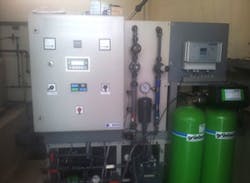POLLUTEC: Lyon Plays Host to Environmental Innovation
Now in its 26th year, the Pollutec show in France is set to bring together the water, waste, energy and environmental industries together in Lyon. We take a look at what visitors can expect.
Day after day the news hammers home the message that we have entered a period of change. This change means we must address the environmental and energy challenges in all of society's activities, whether it be in industry (more responsible production), in local authorities (improvement in living conditions, homes, transport,...) or in the service sector (reducing the impact of offices, hospitals and other institutions). Pollutec 2014 sets out to provide answers to all of these different challenges. Pollutec, which runs from December 2-5 at the Lyon Eurexpo (France), will be highlighting new developments and all that the environment and energy industries have to offer in response to the major, cross-sector challenges that confront them. This 26th Pollutec edition, will bring together some 2,300 exhibitors, including 30% from abroad.
Pollutec covers all sectors of the environment and the topics that are at the heart of current concerns, such as the management of emerging pollutants, the circular economy (preservation of resources, eco-design, the recovery and exploitation of materials...), atmospheric pollution, urban mobility, biodiversity and natural risks, all of which are viewed primarily in terms of innovation and expertise.
As part of its global approach, the show is highlighting solutions to three major cross-sector challenges: sustainable urban development (Sustainable City focus), high performance, responsible production (Sustainable Industry focus) and sustainable development in the hospital environment (Hospitals and Sustainable Development focus), with each focus being supported by a dedicated programme. There will also be some 400 lectures open to all dealing with important current topics. Topics are set to include smart water, rainwater management, energy efficiency and the impact of developments in regulations on the energy transition, among others.
Over the four days there will be a host of innovative solutions on show on the booths competing for the various awards and trophies and in the forums and themed villages organized by the show's expert partners.
A new Innovation Business Lounge will focus on French and European clean tech companies. Specifically, it will be hosting the "LeCleantech business meetings", which bring together start-ups, major groups and investors to address the latest trends and business opportunities in the market.
Pollutec takes place on December 2-5 at the Lyon Eurexpo, France. For more information, visit: www.pollutec.com.
Pollutec Exhibitor Promotion
Pioneers in Saint Maur des Fossés, France
It was in 1993 when an on-site electro-chlorination unit is installed in France on a drinking water treatment plant. Saint Maur des Fossés elects to use the OSEC®-B system, which is part of the Wallace & Tiernan® family of products, as part of their disinfection strategy.
The problem
Saint Maur is a suburb of the ever sprawling city of Paris, only seven miles from the city center. It has a population density of over 6650 people/km2, which increases concerns over transportation and storage of chlorine gas. In France, when a site has to store over 500 kg of chlorine it falls under a specific ICPE classification.
The site needs to receive an authorization from the local authorities. This certificate is usually obtained after hiring a consulting firm that produces a report which is then examined and approved (or not) by the local environmental and health authorities.
This process is costly and requires sites like the St Maur water treatment plant to follow a stringent protocol for the handling and storage of chlorine.
The solution
The OSEC-B systems produce sodium hypochlorite on demand by combining a salt solution and electricity inside a cell of electrodes. This is where the brine is electrolyzed into sodium hypochlorite (NaOCl).
Since the OSEC-B system produces <1.0 wt% solution of sodium hypochlorite on demand, there is no major storage facility needed, no need for handling dangerous chemicals and it does not create inconvenient protocols for delivery of hazardous materials. The only material that needs to be delivered is salt.
In terms of daily operations, the operator just needs to keep an eye on the salt levels and make sure they do not fall too low. The Saint Maur plant has a 15 cubic meter silo, which is refilled with salt by a truck two to three times yearly. The annual average salt consumption is approximately 25 metric tons.
Once the salt is in the silo, the whole process is automated. The OSEC-B system produces sodium hypochlorite which is pumped to a storage tank. When the tank is full, the unit stops and when the tank level is low the unit automatically starts producing again.
Saint Maur water treatment plant produced more than five million cubic meters of water disinfected by the OSEC-B system in 2013.
The result
Madame Heuillard, head of production and quality at St Maur, said: "Yes, the OSEC-B electrolyzer was initially installed to reduce the risk and help with the plant's ICPE classification. But really we ended up getting a lot more out of it. The supply of salt is much more flexible than chlorine, and the ease of operation is optimal. It just runs on its own once the salt is supplied. There is no risk of chlorine gas leaks, and the hydrogen detection system has never gone off in over 20 years of operation. The operating costs have been reduced because the salt is inexpensive, and the maintenance costs are very low."
In fact, the first significant maintenance on the OSEC-B system was performed in 2013, 20 years after the unit was first installed. The electrode cell was cleaned with an acid solution and was put right back into service.
Today, the OSEC-B electrolyzer is still running, 21 years after it was first installed. Since then, the only major component that has been replaced is the water softener. The Saint Maur water treatment plant concerns over the ICPE classification were solved with the application of on-site chlorination. The benefit of having very low operating costs and the ease of operation and maintenance were an added plus.
www.evoqua.com
More Water & WasteWater International Archives Issue Articles




